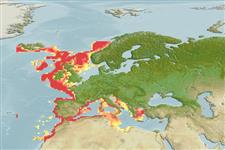分類 / Names
共通名の | 類義語 | Catalog of Fishes(部類, 種) | ITIS | CoL | WoRMS | Cloffa
板鰓亜鋼(サメとエイ類) (sharks and rays) >
Rajiformes (Skates and rays) >
Rajidae (Skates)
Etymology: Leucoraja: Greek, leykos = white + Latin, raja = a fish, Raja sp. (Ref. 45335).
Environment: milieu / climate zone / depth range / distribution range
生態学
海 底生の; 深さの範囲 10 - 800 m (Ref. 106604). Temperate; 67°N - 27°N, 25°W - 37°E
Eastern Atlantic (Iceland, southern Norway, Skagerrak and Morocco) and the Mediterranean Sea.
Records as far south to Mauritania and Senegal could not be verified due to lacking descriptions and specimens; most are probably misidentifications of Leucoraja leucosticta.
サイズ / 重さ / 年齢
Maturity: Lm ? range ? - ? cm
Max length : 120 cm TL オス/雌雄の選別がない; (Ref. 4426); 117.0 cm TL (female); common length : 70.0 cm TL オス/雌雄の選別がない; (Ref. 4426)
簡単な記述
検索表 | 形態学 | 形態計測学
背面の脊椎 (合計) : 0; 肛門の骨: 0. Snout short, its tip somewhat pronounced; upper surface entirely spinulose, about 8 thorns generally in a complete row around inner margin of eye and a triangle of thorns on nape or shoulder region; underside with prickles only on snout, between gill-slits, along abdomen, and at anterior margins of disc; tail only slightly longer than body; upper surface reddish-brown to dark brown with 4-6 creamy spots on each wing, underside white (Ref. 3167).
Found in offshore shelf waters and on upper slope, mainly around the 100 m line (Ref. 3167). Depth range from 70-275 m (Ref. 03167), and from 463-676 m in eastern Ionian Sea (Ref. 56504). Feed on all kinds of bottom animals (Ref. 3167). Oviparous. Distinct pairing with embrace. Young may tend to follow large objects, such as their mother (Ref. 205). Eggs are oblong capsules with stiff pointed horns at the corners deposited in sandy or muddy flats (Ref. 205). Egg capsules are 8.3-9.2 cm long and 4.6-5.3 cm wide (Ref. 41303, 41251, 41311). Maximum length for female is 117 cm (Ref. 41333).
Life cycle and mating behavior
成熟 | 繁殖 | 放精 | 卵 | 生産力 | 幼生
Oviparous, paired eggs are laid. Embryos feed solely on yolk (Ref. 50449). With no definite egg laying period (Ref. 3167). Distinct pairing with embrace. Young may tend to follow large objects, such as their mother (Ref. 205).
McEachran, J.D. and K.A. Dunn, 1998. Phylogenetic analysis of skates, a morphologically conservative clade of elasmobranchs (Chondrichthyes: Rajidae). Copeia 1998(2):271-290. (Ref. 27314)
IUCNのレッドリストの状況は (Ref. 130435: Version 2024-2)
絶滅危惧 (EN) (A2bcd); Date assessed: 30 October 2014
Human uses
水産業: 少数商業の
用具
特記事項
XMLをダウンロードして下さい
インターネットの情報源
Estimates based on models
Preferred temperature (Ref.
123201): 7.5 - 14.2, mean 11.3 °C (based on 116 cells).
Phylogenetic diversity index (Ref.
82804): PD
50 = 0.5000 [Uniqueness, from 0.5 = low to 2.0 = high].
Bayesian length-weight: a=0.00269 (0.00166 - 0.00436), b=3.20 (3.06 - 3.34), in cm total length, based on LWR estimates for this species & Genus-body shape (Ref.
93245).
栄養段階 (Ref.
69278): 3.5 ±0.37 se; based on food items.
回復力 (Ref.
120179): 低い, 4.5年~14年の倍増期間の最小個体群 (Fec assumed to be <100).
Fishing Vulnerability (Ref.
59153): High to very high vulnerability (72 of 100).
Climate Vulnerability (Ref.
125649): Moderate to high vulnerability (48 of 100).
Nutrients (Ref.
124155): Calcium = 4.74 [0.63, 82.48] mg/100g; Iron = 0.236 [0.022, 2.817] mg/100g; Protein = 15.9 [13.8, 17.8] %; Omega3 = 0.712 [0.315, 1.677] g/100g; Selenium = 17.7 [3.6, 87.5] μg/100g; VitaminA = 4.71 [0.36, 55.36] μg/100g; Zinc = 0.34 [0.02, 3.76] mg/100g (wet weight);
